Ultrafast Fiber Optic Photoreceivers
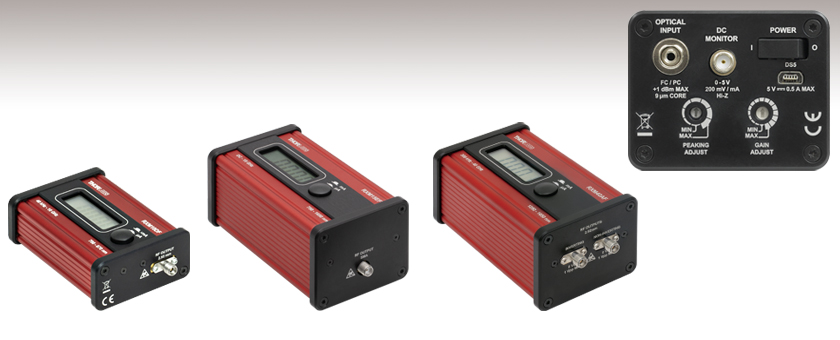
- Models Cover Wavelengths from 700 nm to 1650 nm
- Internal Multimode or Single Mode Fiber with FC/PC Connector
- Maximum Bandwidth from 10 GHz to 42 GHz
- Integrated Photodiode and Low-Noise Transimpedance Amplifier
RXM42AF
Single Mode,
45 kHz to 42 GHz,
800 - 1650 nm
Input Panel of the RXM25AF 25 GHz Single Mode Receiver
RXM15EF
Multimode,
DC to 15 GHz,
750 - 1650 nm
RXM10BF
Multimode,
40 kHz to 15 GHz,
750 - 1650 nm

Please Wait
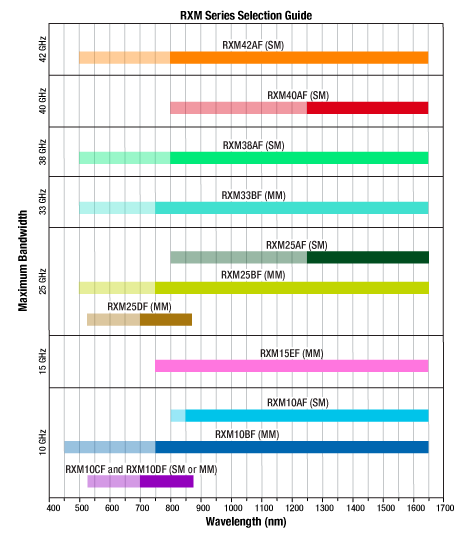
Click to Enlarge
While each RXM Series model is designed and intended for operation over the specified wavelength range shown by the solid colored regions above, each will respond with reduced performance to optical inputs at shorter wavelengths, as shown by the partially transparent regions.
Features
- Hermetically Sealed GaAs or InGaAs Amplified Detector Module
- Three Internal Fiber Options:
- OM4 (Ø50 µm Core) Multimode Fiber
- OM1 (Ø62.5 µm Core) Multimode Fiber (Item # RXM15EF)
- SMF-28 Single Mode Fiber
- AC-Coupled RF Output Signal(s) via 2.92 mm (K) Connector(s)
- Non-Inverting Output on 10 GHz RXM Series Photoreceivers
- Differential Outputs on 25 GHz, 33 GHz, 38 GHz, 40 GHz, and 42 GHz RXM Series Photoreceivers
- DC-Coupled, Inverting RF Output Signal via SMA Connector (Item # RXM15EF)
- Built-In DC Photocurrent Monitor
- Digital Output Sent to Display
- Analog Output via SMA Connector
- Replacement Power Supply Available
- Packaged Instrument Versions of Our OEM Module Photoreceivers
The RXM Series of Ultrafast Receivers includes multimode and single mode fiber-coupled photoreceivers with wide wavelength ranges. The core element of each receiver is a fiber-coupled, hermetically sealed microwave detector module. For convenience and simplicity of use, the module is mounted inside a rugged aluminum housing that includes current monitor circuitry and a digital display of the DC photocurrent.
Our multimode receivers contain Ø50 µm core OM4 multimode fiber (Thorlabs' GIF50E Graded-Index Multimode Fiber) or Ø62.5 µm core OM1 multimode fiber, while our single mode receivers contain Ø9 µm core SMF-28 single mode fiber. Optical input can be coupled from an FC/PC-terminated fiber via the narrow key FC bulkhead connector. Custom units with FC/APC connectors are also available upon request; please contact Tech Support with inquiries. While single mode receivers are intended for use with single mode fiber patch cables, our multimode receivers are designed to accept input from multimode or single mode optical fiber connectors, making them versatile measurement instruments for research and commercial applications. We offer multimode and single mode hybrid patch cables to facilitate connecting optical cables with different connector types and GRIN multimode patch cables for reduced modal dispersion.
RF signal output(s) are available via female 2.92 mm RF connector(s), except for Item # RXM15EF which provides an inverting RF output through a female SMA connector. The RF output signals can be connected to a measurement instrument using suitable microwave cables or adapters. For differential output devices (25 GHz, 33 GHz, 38 GHz, 40 GHz, and 42 GHz RXM receivers), one input is inverting and the other is non-inverting, and each output is labeled. If only one RF output is being used, the unused port should be capped with a 50 Ω terminator; two are included with each receiver. Both RF ports may also be used simultaneously. Measurements of the DC photocurrent can be viewed using the digital display, and an SMA jack on the input panel provides the analog current monitor output signal. Please see the Operation tab for additional information on functionality and operation.
Got Questions?
Our engineers and expertise are here for you!

Janis Valdmanis, Ph.D. Optics
Ultrafast Optoelectronics
General Manager
If you are not sure whether our catalog items meet your needs, we invite you to contact us. Or ask about a loan, so you can try them out for yourself, in your own lab. We can also support custom or OEM requirements you may have.
Just press the button, and we'll get back to you within the next business day.
The 25 GHz and 40 GHz receivers have a peaking adjuster with 8 and 4 discrete settings, respectively, and a gain adjuster with 16 discrete settings. The 33 GHz, 38 GHz and 42 GHz receivers have only a gain adjuster. The gain adjustment changes the amplitude of the output swing for a given input signal while the peaking adjustment changes the shape of the frequency response. A larger peaking value corresponds to higher magnitudes at high frequencies. By utilizing these two adjustments, a user can maximize the performance of the receiver for a specific application.
The RXM33BF, RXM38AF and RXM42AF receivers use the same amplifier but different photodiodes. The RXM33BF receiver uses a larger photodiode that is slower and has a lower bandwidth, but makes it possible to couple light from a multimode input fiber. The 38 GHz photoreceiver uses a photodiode which has slightly higher responsivity, but less bandwidth. The RXM42AF receiver uses a photodiode that has higher bandwidth, but less responsivity. The RXM40AF photoreceiver provides a larger output swing than either the RXM38AF or RXM42AF receivers. However, the RXM33BF, RXM38AF and RXM42AF receivers have a smoother frequency response roll-off, lower noise, and less change in frequency response as a function of gain.
Click the blue Info icon (![]() ) in the tables below to see a full list of specifications and performance graphs for a specific item.
) in the tables below to see a full list of specifications and performance graphs for a specific item.
Included with each RXM series photoreceiver is a power adapter with a mini-B USB plug and a mounting bracket that snaps onto the side of the housing; the 10 GHz devices come with the ECM100 bracket, and the ECM175 bracket is included with the 15 GHz, 25 GHz, 33 GHz, 38 GHz, 40 GHz, and 42 GHz photoreceivers. Each bracket has a #8 (M4) counterbore, which allows easy mounting to a post or any other component with an 8-32 (M4) threaded hole.
The performance of each RXM series photoreceiver can be downloaded by clicking on the red Docs icon (![]() ) next to the Item # and entering your device's serial number under the "Download Serial Item Data." A sample of these results for the RXM40AF ultrafast photoreceiver can be viewed here. Please contact Tech Support for test results for items purchased prior to 2020.
) next to the Item # and entering your device's serial number under the "Download Serial Item Data." A sample of these results for the RXM40AF ultrafast photoreceiver can be viewed here. Please contact Tech Support for test results for items purchased prior to 2020.
| Webpage Features | |
|---|---|
| Clicking this icon below opens a window that contains full specifications and performance graphs for each item. | |
| Clicking this icon below allows you to download our standard support documentation for each item. | |
Quick Start Guide

ESD Sensitive Components: Please note that the components inside the RXM series units are ESD sensitive. Take all appropriate precautions to discharge personnel and equipment before making any electrical connections to the unit. This especially applies to coaxial connecting cables that can accumulate capacitive charge.
Mounting the Detector: The included mounting clamp, also available separately below, has a single counterbore that accepts an 8-32 (M4) cap screw (not included). Screw the clamp to the desired base or post before snapping it to the side of the detector housing and securing it using the integrated 5/64" (2 mm) locking screw.
RF and Photocurrent Monitor Output: Connection cables attached to the RF output ports (shown in Figures 1, 4, 7, and 10) and SMA photocurrent monitor port (shown in Figures 2, 5, 8, and 11) must be properly shielded. Attach the RF output of the RXM series unit to the measurement instrument using suitable cables or adapters, such as Thorlabs' microwave cables and adapters. If only one RF port is used on the differential output devices, cap the unused port with a 50 Ω terminator; two are included with each unit. The measurement instrument must have a 50 Ω input and adequate bandwidth to resolve the high-speed signal from the RXM series ultrafast receiver.
Optical Fiber Input: Ensure the input optical power does not exceed the absolute max rating; this is +4 dBm for the 15 GHz receiver, +6 dBm for the 10 GHz receivers, +7 dBm for the 38 GHz receiver, and +10 dBm for the 25 GHz, 40 GHz, and 42 GHz devices. The FC/PC bulkhead connector used to couple the optical input signal to the detector is located on the input panel of the unit (shown in Figures 2, 5, 8, and 11). Fiber connector tips should be cleaned properly before making any connections. Input fiber for single mode detectors should be SMF-28 or equivalent. Input fiber for multimode detectors should be OM1 (Item # RXM15EF), OM4, SMF-28, or equivalents.
DC Photocurrent Monitor: The DC photocurrent can be monitored directly by viewing the built-in digital display (shown in Figures 3, 6, 9 and 12), as well as by using most voltmeters to read the analog voltage signal output via the high-impedance SMA jack located on the input panel (shown in Figures 2, 5, 8, and 11). The units on the displayed digital current measurement can be toggled between µA and mA using the button on the front panel. There may be a small discrepancy (within specification) between the screen and SMA monitor output signal. The digital display reports a wide range of current values, up to 20 mA with a resolution of 1 nA, with the display automatically changing range in response to the signal magnitude. The analog voltage signal sent to the SMA connector has a linear relationship with the measured DC photocurrent up to 3.5 V: the transimpedance gain of the current monitor provides 200 mV per 1 mA of photocurrent. This linear relationship limits the current range reported by the analog SMA output signal, so that the range is smaller than that provided by the digital display.
Cleaning the Housing: Use a soft cloth moistened with mild glass cleaner. Do not spray directly onto unit.
RXM10 Series Housing Features
While the RXM10AF receiver is shown below, these features are representative of all 10 GHz devices on this page.
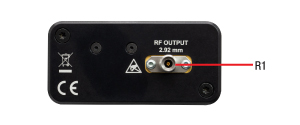
Click to Enlarge
Figure 1: Output Panel
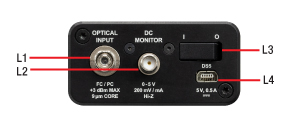
Click to Enlarge
Figure 2: Input Panel
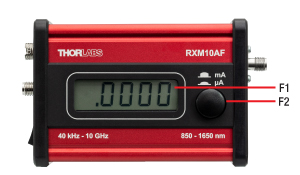
Click to Enlarge
Figure 3: Front Panel
| Label | Feature |
|---|---|
| R1 | RF Output, Non-Inverting (Female 2.92 mm; 8 in-lbs Torque Spec) |
| Label | Feature |
|---|---|
| L1 | 2.0 mm Narrow Key FC/PC (FC/APC Available Upon Request) |
| L2 | Current Monitor Output (Female SMA; 5 in-lbs Torque Spec) |
| L3 | Power Switch |
| L4 | Mini-B USB Power Jack for +5 VDC Input |
| Label | Feature |
|---|---|
| F1 | Photocurrent Monitor Display (4.5 Characters) |
| F2 | Range Toggle Switch |
RXM15EF Housing Features
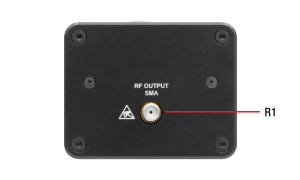
Click to Enlarge
Figure 4: Output Panel
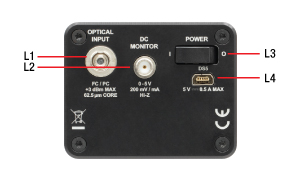
Click to Enlarge
Figure 5: Input Panel
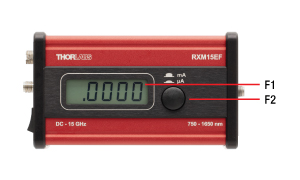
Click to Enlarge
Figure 6: Front Panel
| Label | Feature |
|---|---|
| R1 | RF Output, Inverting (Female SMA; 5 in-lbs Torque Spec) |
| Label | Feature |
|---|---|
| L1 | 2.0 mm Narrow Key FC/PC (FC/APC Available Upon Request) |
| L2 | Current Monitor Output (Female SMA; 5 in-lbs Torque Spec) |
| L3 | Power Switch |
| L4 | Mini-B USB Power Jack for +5 VDC Input |
| Label | Feature |
|---|---|
| F1 | Photocurrent Monitor Display (4.5 Characters) |
| F2 | Range Toggle Switch |
RXM25 Series and RXM40AF Housing Features
While the RXM25AF receiver is shown below, these features are representative of all 25 GHz and 40 GHz devices on this page.
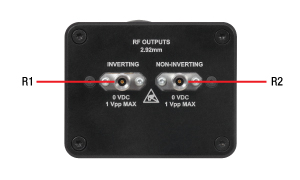
Click to Enlarge
Figure 7: Output Panel
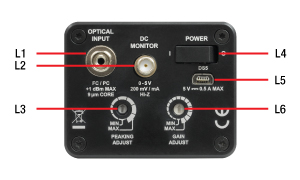
Click to Enlarge
Figure 8: Input Panel
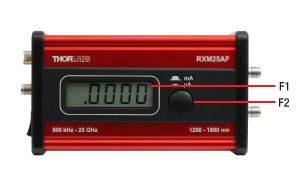
Click to Enlarge
Figure 9: Front Panel
| Label | Feature |
|---|---|
| R1 | RF Output, Inverting (Female 2.92 mm; 8 in-lbs Torque Spec) |
| R2 | RF Output, Non-Inverting (Female 2.92 mm; 8 in-lbs Torque Spec) |
| Label | Feature |
|---|---|
| L1 | 2.0 mm Narrow Key FC/PC (FC/APC Available Upon Request) |
| L2 | Current Monitor Output (Female SMA; 5 in-lbs Torque Spec) |
| L3 | Peaking Adjuster |
| L4 | Power Switch |
| L5 | Mini-B USB Power Jack for +5 VDC Input |
| L6 | Gain Adjuster |
| Label | Feature |
|---|---|
| F1 | Photocurrent Monitor Display (4.5 Characters) |
| F2 | Range Toggle Switch |
RXM33BF, RXM38AF and RXM42AF Housing Features
While the RXM42AF receiver is shown below, these features are representative of all 33 GHz, 38 GHz and 42 GHz devices on this page.
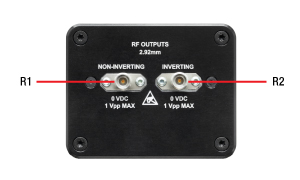
Click to Enlarge
Figure 10: Output Panel
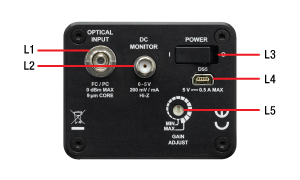
Click to Enlarge
Figure 11: Input Panel

Click to Enlarge
Figure 12: Front Panel.
| Label | Feature |
|---|---|
| R1 | RF Output, Non-Inverting (Female 2.92 mm, 8 in-lbs Torque Spec) |
| R2 | RF Output, Inverting (Female 2.92 mm, 8 in-lbs Torque Spec) |
| Label | Feature |
|---|---|
| L1 | 2.0 mm Narrow Key FC/PC (FC/APC Available Upon Request) |
| L2 | Current Monitor Output (Female SMA; 5 in-lbs Torque Spec) |
| L3 | Power Switch |
| L4 | Mini-B USB Power Jack for +5 VDC Input |
| L5 | Gain Adjuster |
| Label | Feature |
|---|---|
| F1 | Photocurrent Monitor Display (4.5 Characters) |
| F2 | Range Toggle Switch |
Components Included with the RXM Series Ultrafast Detectors
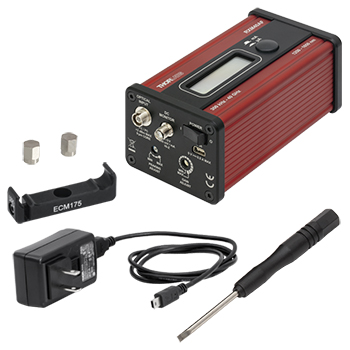
Click to Enlarge
Components of the RXM40AF Ultrafast Receiver
10 GHz RXM Photoreceivers
15 GHz RXM Photoreceiver
25 GHz, 33 GHz, 38 GHz, 40 GHz, and 42 GHz RXM Photoreceivers

Janis Valdmanis, Ph.D. Optics
Ultrafast Optoelectronics
General Manager
Custom and OEM Options
When your application requirements are not met by our range of catalog products or their variety of user-configurable features, please contact me to discuss how we may serve your custom or OEM needs.
Request a Demo Unit
Explore the benefits of using a Thorlabs high-speed instrument in your setup and under your test conditions with a demo unit. Contact me for details.
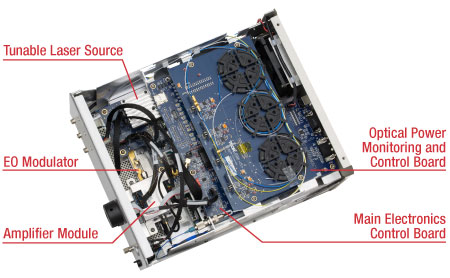
Click to Enlarge
The MX40B Digital Reference Transmitter
Design, Manufacturing, and Testing Capabilities
Thorlabs' Ultrafast Optoelectronics Team designs, develops, and manufactures high-speed components and instrumentation for a variety of photonics applications having frequency responses up to 110 GHz. Our extensive experience in high-speed photonics is supported by core expertise in RF/microwave design, optics, fiber optics, optomechanical design, and mixed-signal electronics. As a division of Thorlabs, a company with deep vertical integration and a portfolio of over 20,000 products, we are able to provide and support a wide selection of equipment and continually expand our offerings.
Our catalog and custom products include a range of integrated fiber-optic transmitters, modulator drivers and controllers, detectors, receivers, pulsed lasers, variable optical attenuators, and a variety of accessories. Beyond these products, we welcome opportunities to design and produce custom and OEM products that fall within our range of capabilities and expertise. Some of our key capabilities are:
- Detector and Receiver Design, to 70 GHz
- Fiber-Optic Transmitter Design, to 110 GHz
- RF & Microwave Design and Simulation
- Design of Fiber-Optic and Photonics Sub-Assemblies
- High-Speed Testing, to 110 GHz
- Micro-Assembly and Wire Bonding
- Hermetic Sealing of Microwave Modules
- Fiber Splicing of Assemblies
- Custom Laser Engraving
- Qualification Testing
Overview of Custom and Catalog Products
Our catalog product line includes a range of integrated fiber-optic transmitters, modulator drivers and controllers, detectors, pulsed lasers, and accessories. In addition to these, we offer related items, such as receivers and customized catalog products. The following sections give an overview of our spectrum of custom and catalog products, from fully integrated instruments to component-level modules.
Fiber-Optic Instruments
To meet a range of requirements, our fiber-optic instruments span a variety integration levels. Each complete transmitter includes a tunable laser, a modulator with driver amplifier and bias controller, full control of optical output power, and an intuitive touchscreen interface. The tunable lasers, modulator drivers, and modulator bias controllers are also available separately. These instruments have full remote control capability and can be addressed using serial commands sent from a PC.
- Fiber-Optic Transmitters, to 110 GHz
- Linear and Digital Transmitters
- Electrical-to-Optical Converters, to 110 GHz
- Modulator Drivers
- Modulator Bias Controllers
- C- and L-Band Tunable Lasers
Customization options include internal laser sources, operating wavelength ranges, optical fiber types, and amplifier types.
Fiber-Optic Components
Our component-level, custom and catalog fiber-optic products take advantage of our module design and hermetic sealing capability. Products include detectors with frequency responses up to 50 GHz, and we also specialize in developing fiber-optic receivers, operating up to and beyond 40 GHz, for instrumentation markets. Closely related products include our amplifier modules, which we offer upon request, variable optical attenuators, microwave cables, and cable accessories.
- Hermetically-Sealed Detectors, to 50 GHz
- Fiber-Optic Receivers, to 40 GHz
- Amplifier Modules
- Electronic Variable Optical Attenuators
- Microwave Cables and Accessories
Customization options include single mode and multimode optical fiber options, where applicable, and detectors optimized for time or frequency domain operation.
Free-Space Instruments
Our free-space instruments include detectors with frequency responses around 1 GHz and pulsed lasers. Our pulsed lasers generate variable-width, nanosecond-duration pulses, and a range of models with different wavelengths and optical output powers are offered. User-adjustable repetition rates and trigger in/out signals provide additional flexibility, and electronic delay-line products enable experimental synchronization of multiple lasers. We can also adapt our pulsed laser catalog offerings to provide gain-switching capability for the generation of pulses in the 100 ps range.
- Pulsed Lasers with Fixed 10 ns Pulse Duration
- Pulsed Lasers with Variable Pulse Width and Repetition Rates
- Electronic Delay Units to Synchronize NPL Series Pulsed Lasers
- Amplified Detectors
Customization options for the pulsed lasers include emission wavelength, optical output powers, and sub-nanosecond pulse widths.
| Posted Comments: | |
Nicolas Forget
(posted 2023-09-25 07:29:10.493) I was wondering: is the AC-coupling before or after the broadband amplifier? ksosnowski
(posted 2023-09-28 05:20:13.0) Thanks for reaching out to Thorlabs. There is AC coupling both within and after the amplifier. I have reached out directly to discuss your application in further detail. Yanfei Bai
(posted 2023-03-21 18:28:01.72) Wondering if there is any Oband data for this 40GHz data, especially differential gain at O-band . Haonan Wu
(posted 2022-10-20 17:43:01.977) Hello This is Haonan Wu from U of I. I previously purchased both RXM42AF and RXM25BF. But we don't have responsivity data at 850 nm and 880 nm. Can you provide the responsivity data for both PDs?
Thank you jgreschler
(posted 2022-11-01 11:30:17.0) Thank you for reaching out to Thorlabs. Additional specs and data can be requested by contacting techsupport@thorlabs.com. I have reached out to you to discuss this application. |


| Item #a | Full Specs |
Fiber Type | Bandwidth | Wavelength Range |
Responsivity | Conversion Gainb |
Optical Return Loss (Max) |
Noise-Equivalent Power (NEP)c |
Current Monitor Outputd |
|---|---|---|---|---|---|---|---|---|---|
| RXM25DF | Ø50 µm MM OM4 | 500 kHz - 25 GHz | 700 - 870 nm | 0.5 A/W | 75 - 4800 V/W | -14 dB | 24 pW/√Hz | 200 mV/mA | |
| RXM25BF | Ø50 µm MM OM4 | 500 kHz - 25 GHze | 750 - 1650 nm | 0.75 A/W | 110 - 7200 V/W | -12 dB | 15 pW/√Hz | ||
| RXM25AF | Ø9 µm SMF-28 | 500 kHz - 25 GHz | 1250 - 1650 nm | 0.75 A/W | 110 - 7200 V/W | -28 dB | 15 pW/√Hz |

| Item #a | Full Specs |
Fiber Type | Bandwidth | Wavelength Range |
Responsivityb | Conversion Gainc |
Optical Return Loss (Max) |
Noise-Equivalent Power (NEP)b,d |
Current Monitor Outpute |
|---|---|---|---|---|---|---|---|---|---|
| RXM33BF | Ø50 µm OM4 | 45 kHz - 33 GHz | 750 - 1650 nm | 0.7 A/W | 95 - 3150 V/W | -13 dB | 22 pW/√Hz | 200 mV/mA |

| Item #a | Full Specs |
Fiber Type | Bandwidth | Wavelength Range |
Responsivity | Conversion Gainb |
Optical Return Loss (Max) |
Noise-Equivalent Power (NEP)c |
Current Monitor Outputd |
|---|---|---|---|---|---|---|---|---|---|
| RXM38AF | Ø9 µm SMF-28 | 45 kHz - 38 GHz | 800 - 1650 nm | 0.75 A/W | 100 - 3300 V/W | -25 dB | 19 pW/√Hz | 200 mV/mA |

| Item #a | Full Specs |
Fiber Type | Bandwidth | Wavelength Range |
Responsivity | Conversion Gainb |
Optical Return Loss (Max) |
Noise-Equivalent Power (NEP)c |
Current Monitor Outputd |
|---|---|---|---|---|---|---|---|---|---|
| RXM40AF | Ø9 µm SMF-28 | 300 kHz - 40 GHz | 1250 - 1650 nm | 0.7 A/W | 140 - 3650 V/W | -28 dB | 24 pW/√Hz | 200 mV/mA |

| Item #a | Full Specs |
Fiber Type | Bandwidth | Wavelength Range |
Responsivity | Conversion Gainb |
Optical Return Loss (Max) |
Noise-Equivalent Power (NEP)c |
Current Monitor Outputd |
|---|---|---|---|---|---|---|---|---|---|
| RXM42AF | Ø9 µm SMF-28 | 45 kHz - 42 GHz | 800 - 1650 nm | 0.6 A/W | 100 - 2700 V/W | -15 dB | 23 pW/√Hz | 200 mV/mA |

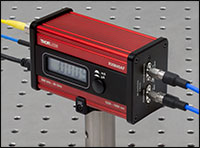
Click to Enlarge
RXM40AF Photoreceiver Mounted on Ø1" Post Using an ECM175 Aluminum Clamp
- Post-Mountable Aluminum Clamps
- Double-Sided Plastic Clamps (Sold in Packs of Two)
- One ECM100 Clamp Is Included with Each 10 GHz RXM Series Photoreceiver
- One ECM175 Clamp Is Included with Each 15 GHz, 25 GHz, 40 GHz, and 42 GHz RXM Series Photoreceiver
Each RXM Series Photoreceiver includes one anodized aluminum clamp, which snaps onto the bottom of the detector's housing and is secured by tightening the flexure lock using the 2 mm (5/64") hex locking screw. The ECM100 clamp is included with the 10 GHz receivers, while the 15 GHz, 25 GHz, 40 GHz, and 42 GHz devices come with the ECM175 clamp. Additional aluminum and plastic clamps are available separately. These clamps are part of Thorlabs' family of side clamps that are designed to securely mount Thorlabs' rectangular electronics housings.
Aluminum Clamps
Both the ECM100 and ECM175 clamp have a #8 (M4) counterbore on the bottom; the ECM225 has three of these counterbores. The counterbores allow these clamps to be mounted onto a Ø1/2" post or any surface with an 8-32 (M4) tap. The clamp must be mounted via the counterbored through hole before the electronics housing is attached, as the counterbore will not be accessible once the housing is secured in the clamp.
Double-Sided Plastic Clamps
The EPS175 and EPS225 ABS plastic clamps are sold in pairs and easily snap onto the side of the electronics housing. Each clamp is designed to attach two housings with a common side width.

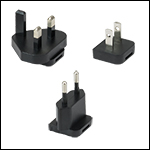
Click for Details
Region-Specific Adapters for DS5
- 5 VDC Regulated Power Supply
- USB Type-A Port
- Compatible with Our DXM and RXM Series of Ultrafast Detectors and Photoreceivers
The DS5 is a 5 V regulated power supply with a USB Type-A female port. It can be used with any USB-compatible device that accepts a 5 VDC output, and is directly compatible with our DXM series of ultrafast fiber optic detectors and our RXM series of ultrafast fiber optic receivers when used with the USB-AB-72 USB cable (sold separately). In addition to the USB-AB-72, we also offer other USB 2.0 cables. A region-specific adapter plug is shipped with the DS5 power supply unit based on your location.
 Products Home
Products Home
















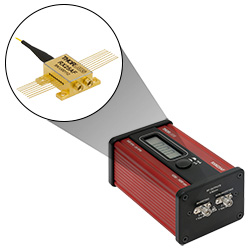
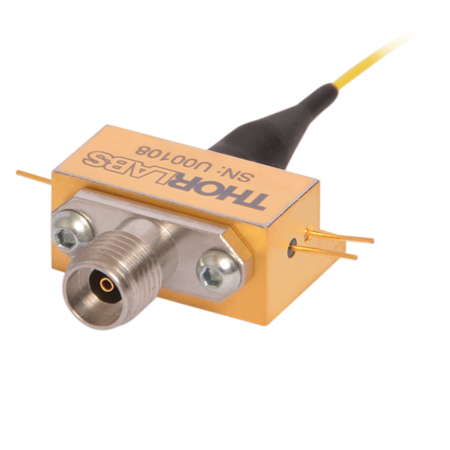
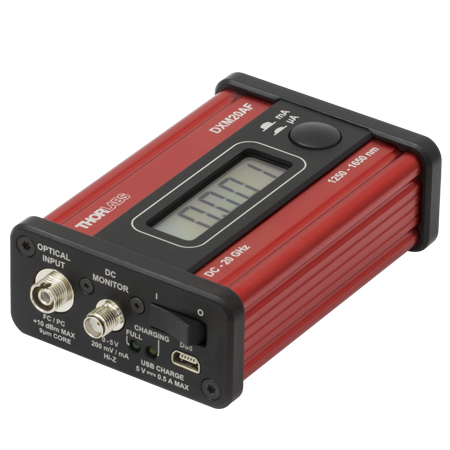




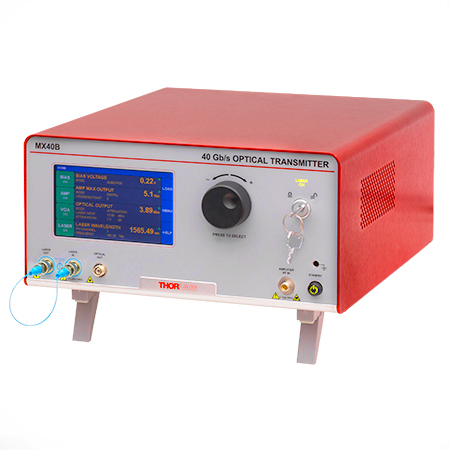


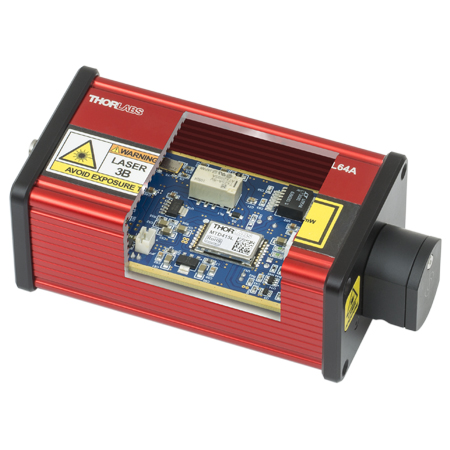

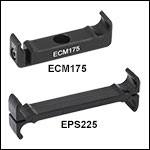
 Zoom
Zoom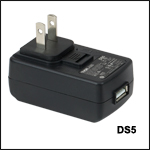
 Telecom-Grade Fiber-Coupled Photoreceivers
Telecom-Grade Fiber-Coupled Photoreceivers